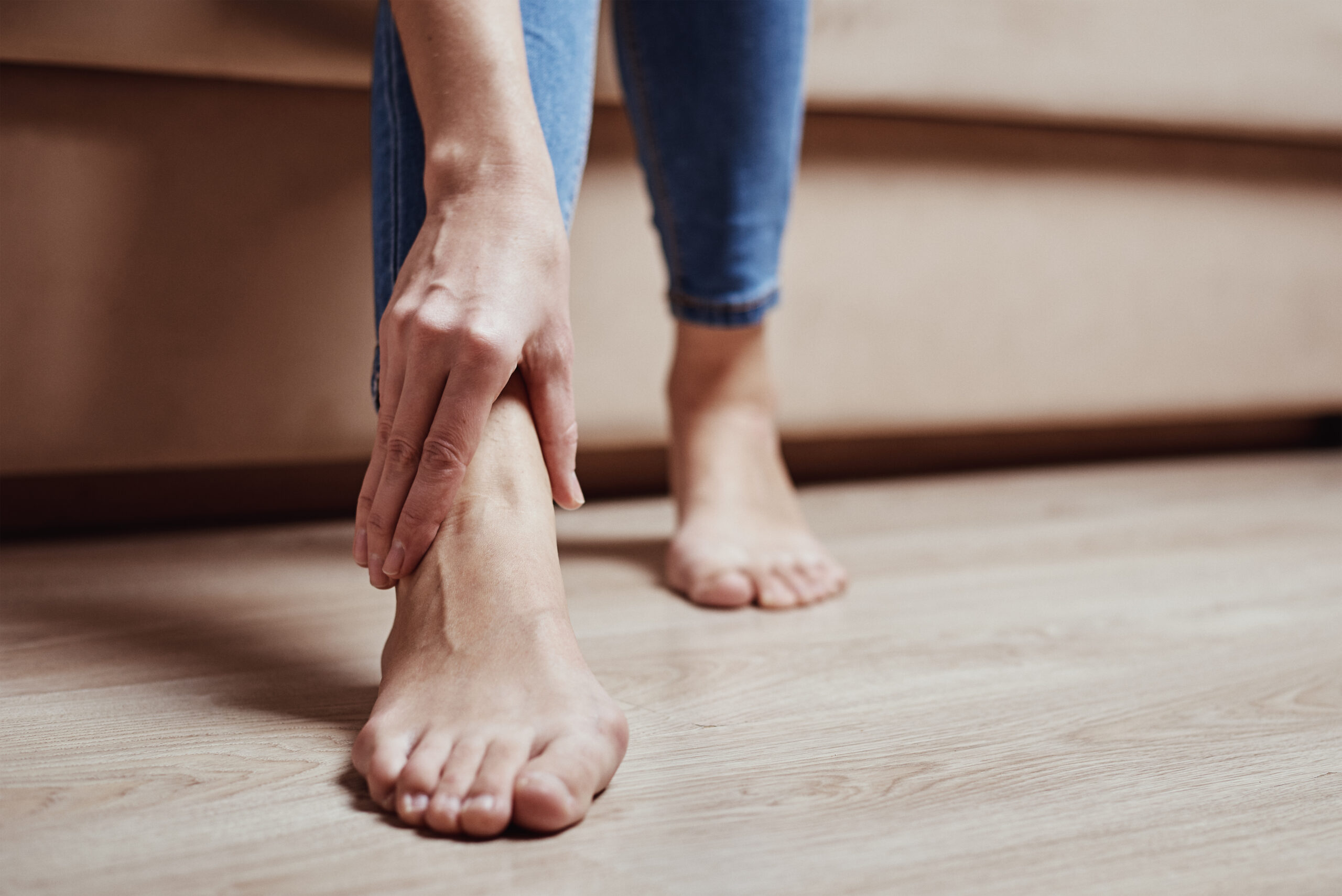There are a number of treatments available for sudden ankle pain without injury. A healthcare professional will need to perform a full examination before recommending appropriate treatments
Possible Reasons for Sudden Ankle Pain without Injury
Osteoarthritis:
Osteoarthritis (OA) is the most common form of arthritis, and it can occur in the ankle joint. OA in the ankles occurs through wear and tear of the joint that causes the cartilage and bone to break down and change. Causes of OA in the ankles may include age, previous injury, and weight. OA in the ankles is more common in older adults. Any former ankle injury can lead to OA in the ankles, although symptoms may not show for years after the injury. If a person is overweight or obese, it may put more stress on the ankles.
Symptoms of OA include pain, aching, or swelling in the ankles. Stiffness in the ankles, especially in the morning or after periods of rest are signs of OA. Additionally, lack of flexibility, poor range of motion, instability, or looseness in the ankle joints.
There are several treatments that may help relieve symptoms of OA in the ankles, like physical therapy directed exercise or ankle stretches. Medications such as corticosteroids, anti-inflammatory medications (NSAIDs), pain relievers, topical rubs, creams, or sprays. Surgery such as an ankle arthroscopy.
Reactive arthritis:
Reactive arthritis is an inflammatory disease that occurs as a reaction to an infection in the digestive tract, urinary tract, or genitals. It can cause symptoms such as pain and inflammation that come on suddenly, with joints such as the ankles affected.
Symptoms of reactive arthritis typically start 2–4 weeks after the infection. Once symptoms start, they typically develop over the course of a few days. Some people experience mild symptoms, while others have more severe symptoms that affect daily activities. The most common symptoms of reactive arthritis that affect the ankles are inflammation and pain. Other symptoms include urinary tract inflammation, eye inflammation, fatigue, fever, weight loss, diarrhea and abdominal pain, small mouth ulcers, skin rash, thickened nails, or small ulcers on the penis (in males)
Some treatment options available to help alleviate symptoms of reactive arthritis in the ankles include pain medications such as NSAIDs, corticosteroids, disease-modifying anti rheumatic drugs (DMARDs), antibiotics, or physical therapy.
 Lupus:
Lupus:
Autoimmune diseases occur when a person’s immune system attacks itself because it mistakes healthy tissue for viruses or bacteria. This can cause inflammation in joints such as the ankles, along with other symptoms.
Symptoms they may experience include pain or tenderness, swelling, stiffness, extreme fatigue, skin rashes, fever, sun sensitivity, numb or discolored fingers or toes. A person may experience times when their symptoms flare and times in remission when they feel well.
Some treatment options to help manage symptoms of lupus may include pain medication including NSAIDs, antimalarials, or corticosteroids. A healthy diet and exercise will ease symptoms. Complimentary therapies such as acupuncture or chiropractic treatment.
Posterior tibial tendon dysfunction (PTTD), also known as fallen arches or flat feet, occurs when the tendon supporting the main arch of the foot weakens. This causes the arch of a person’s foot to gradually flatten. PTTD can lead to pain in the ankles and is often caused by overuse of the posterior tibial tendon.
Symptoms of PTTD may include pain and swelling on the inside of the foot and ankle, inward rolling of the ankle (overpronation), flattening of foot arch, or arthritis of the feet and ankle.
Treatments a podiatrist may recommend for PTTD shoe modifications, such as wearing inserts, physical therapy, such as exercises and stretches, pain medications such as NSAIDs, ankle braces, or surgery.
Rheumatoid arthritis:
Rheumatoid arthritis (RA) is an autoimmune, inflammatory disease that affects the lining of the joints. RA typically affects both ankles at the same time and can cause pain. A person with RA in the ankles may experience flares of symptoms that last for a number of days or months, followed by periods of remission.
Symptoms of RA in the ankles include pain, stiffness, tenderness and swelling, often in more than one joint, or the same symptoms on both sides of the body, such as both ankles. Other symptoms include fever, fatigue, weight loss, or weakness.
Treatments a doctor may recommend strategies to try to reduce symptoms of RA in the ankles, including medications such as disease-modifying antirheumatic drugs (DMARDs) or biological response modifiers (biologicals). Exercise and a healthy diet help. Hot and cold treatments, topical creams, gels, or stick-on patches and complementary therapies may relieve symptoms.
Achilles tendonitis:
Achilles tendonitis occurs when the Achilles tendon, which is located in a person’s ankle, becomes painful and inflamed. It often occurs due to overuse, although it is not typically related to a specific injury. Other factors may also put a person at risk of Achilles tendonitis, including older age, a sudden increase in the amount or intensity of exercise, or tight calf muscles. Haglund’s deformity is an enlargement of the bone on the back of a person’s heel.
Some symptoms of Achilles tendonitis can include pain in the heel or Achilles tendon when exercising or applying pressure, pain and stiffness in the heel and tendon in the morning, or continuous swelling that gets worse through the day or with activity. Thickening of the tendon severe pain the day after exercising, pain on the back of the heel when wearing shoes, or bone spur formation are also symptoms of Achilles tendonitis.
A person with ankle pain due to Achilles tendonitis may benefit from the following treatments rest and reducing physical activity impacting the ankles, NSAIDs, supportive footwear, physiotherapy, stretching, or surgery.
Gout:
Gout is an inflammatory form of arthritis that can cause pain in the ankles. It is caused by a condition called hyperuricemia, which is when there is too much uric acid in a person’s body. Gout usually affects one joint at a time, and often starts in a person’s big toe.
Symptoms of gout can start suddenly and last for days or weeks, known as flares. Symptoms may then not reappear for weeks, months, or years. The main symptom of gout in the ankles is intense pain, often at nighttime. The pain may be so severe it causes a person to wake up. Other symptoms of gout in affected joints can include swelling, redness, warmth.
A healthcare professional may recommend the following treatments for gout in the ankle joints NSAIDs, colchicine, corticosteroids and maintaining a healthy lifestyle.
Bursitis:
Bursitis describes inflammation of a bursa. Bursas are fluid-filled sacs located between the bones, muscles, tendons, and ligaments. Bursitis typically affects the shoulders, knees, elbows, hips, or feet, although it can occur in any joint including the ankles.
A person with bursitis in the ankles may experience the following in the ankle joints, especially during movement or when applying pressure swelling, pain, warmth, or redness.
The following treatments may help alleviate symptoms of bursitis in the ankles ice compression medications such as antibiotics, steroid injections, pain medications, splints, physical therapy, or surgical drainage of the bursa in the ankle.
Sudden Ankle Pain without Injury:
Some other causes that may lead to sudden ankle pain without injury include:
Tarsal tunnel syndrome (TTS) occurs when the posterior tibial nerve, which runs along the inside of the foot and ankle, is compressed and damaged.
Sinus tarsi syndrome (STS) causes pain, swelling, and instability in the subtalar joint along the outside of the foot.
Infectious arthritis is a serious, bacterial infection of the joints that causes pain and inflammation.
Sudden Ankle Pain without Injury:
There are multiple reasons why a person may experience sudden ankle pain without injury, from auto-immune conditions to wear and tear. A person should consult a healthcare professional if symptoms are causing severe pain or have lasted for over 2 weeks.
Contact us:
A person should seek medical attention if they experience sudden ankle pain without injury and experience any of the following:
- pain that affects daily activities, or makes a person feel faint or nauseous
- pain that has not improved after 2 weeks
- tingling or loss of sensation in the foot
- the ankle has changed shape and appears to be at an odd angle
If You’re Having Issues with Ankle Pain, Contact the Podiatrists at Garden State Foot and Ankle Group of Toms River Today!
Dr. Manooj Prasad at Garden State Foot & Ankle Group of Toms River is a highly-experienced podiatrist with an ardent mission to help those suffering from foot, ankle, and lower leg issues. He offers personalized care while considering each patient’s individual lifestyle needs so that the best possible treatment can be administered. Based in both Essex County and Ocean County in New Jersey, service towns include Toms River, Jackson, Belleville, Montclair, Lakewood, Cedar Grove, Caldwell, Manchester, Millburn, Livingston, Lakehurst, and many more! For more information, you can contact us today at (732)557-9900 (Toms River) or (973)450-3035 (Belleville) or explore our website.
Toms River Diabetic Wound Care Specialist

0 Comments